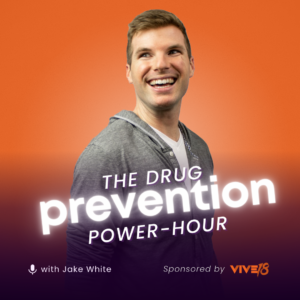“Narrowing the Focus in Youth Drug Prevention: Targeting Specific Student Needs”
[00:00:04] Jake White: Hey, what’s up? It’s your host, Jake White, and welcome back to Party Talk, where we empower leaders in youth drug prevention. I’m so pumped for today’s episode, we’re just going to talk a little bit. And what I want to talk about with you is “How we can narrow our focus in prevention to reach more students?” I believe that we’ve been taking a shotgun approach. Where we spit out information, we spit out data, we spit out stories, but they aren’t targeted to specific students. So in a way where everyone’s hearing us but no one is listening. So there’s the students in one end of the spectrum, and they’re not using drugs or alcohol right now. Some people would argue that we don’t need to do prevention with them, and they would be wrong. Just like in business, you know that keeping a customer is more effective and more cost effective than getting a new customer. Prevention is the same way. So those students who aren’t using, we need to invest in them.
The second type of student is the one who, hey, they’re not using right now, but they’re in circumstances and situations where they could be using. They’re listening to their friends talk about it, but they’re gathering information and they’ve got an issue. Maybe it’s something that’s going on at home, maybe it’s something with their mental health, but there’s a potential reason why they could actually start using drugs and alcohol and they’re at risk for going down that path because of the influence that’s around them and because of the circumstances that they’re under.
Then you have that third group of students and this group has already started using. And actually they found that using a substance is actually a solution to a problem that they had. It might not be a long term solution, but they believe that it is a good solution. If it wasn’t, they wouldn’t be using. So there’s three types of students and I could even argue that there’s probably some in between those as well. We did three, but there might be five or more. So when we think about prevention. When we’re doing a message, when we’re doing a presentation, when we’re starting a club or an organization, if we’re asking them to create content or posters or anything that we want them to do, we first have to think about which students are we targeting, what do they truly want, and what’s in it for them? And a lot of times I see this go wrong when schools are asking me, “Jake, I want you to come in and scare my students straight.” First of all, I don’t like that approach because it’s not effective. Students aren’t led by fear. In fact, when you hit on with scare tactics and fear their responses, that’s not going to happen to me. Or if you share a scary story with them and you’re in front of them telling it, it’s not going to happen to me. But here you are telling this story, you’re okay. So that means I can actually go down these steps, I can mess up and then I’ll be fine too. Or what could happen is they listen to your story, it impacts them, but once they test it, they go out and they do use a substance and nothing bad happens. Then you get put into the box of a liar. They can’t necessarily trust the information that you gave them because you told them something terrible was going to happen.
On the contrary, when you have this approach where you can target students along the spectrum of use of, “I’m going to speak to the students who have already started using.” Let you know the science and the risks, and I’m going to relate it to what you’ve seen already because you have seen some of the signs of danger on that middle section, the ones who could be swayed either way. I’m going to address the mental health issues. I’m going to address the things that could be happening at home, which means we need to teach resilience. It means we need to teach coping strategies. All these things are really important, and it even is important for that first group too. Because even the ones who seem to be sheltered or they seem to be not using at all and not interested, they’re going to experience some challenges. They’re going to be put under pressure or stress to use by their friends or their peers at some point. So we need to continue pouring into them to develop resilience, to develop refusal skills. So when we think about our prevention methods, we have to include all these three types of students. We need to include all the different things that could help them maintain a healthy decision and then also what can turn some of their decisions around. That’s the challenge for you. And if you’re in the space and you got some ideas, if you’ve got ways that you’ve effectively done this, let me know about it. I do this work all across the country, so I see people doing it effectively and I see a lot of people doing this work not so effectively. So I got examples on both sides. But I would love to hear from you. Hit me up at jake@vive18.com and let me know what you’ve been up to.
[00:05:34] Shout Out: And just a quick shout out, Tomas and I will actually be at CADCA at the mid-year convention. And we’ll be speaking to all the students there. You’re going to be at CADCA mid-year in Dallas. Hit me up LinkedIn or e-mail. I would love to meet you. Hear what you’re doing in your coalitions, in your schools for prevention. The presentation that we’re doing at CADCA is called “Ignite Your Influence”. How to engage and influence your peers in prevention. We’ll be bringing a ton of prizes and games. We’re going to have competitions the whole time. So you know how we do things? Like we make everything fun and social. So definitely stop by if you see us, Tomas and I in our 518 shirts, come say hey and we’ll see you in Dallas.
All right. I hope this episode of Party Talk was beneficial for you. Do you have any thoughts on this? If you agree, if you disagree, let me know. And once again, please subscribe to the podcast. We do this every Monday, so we love doing this for free. And if there’s a way you want to say thank you, leaving the review would be a great way to do that.


